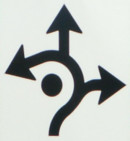by the El Plazuela cul de sac off Junipero Serra, and evidence that the City decided to extend the streets immediately south of the Terraces through to Holloway. The 1912 map shows a solid row of residential lots on the south side of Holloway all the way from Junipero Serra to Ashton. (Note that these streets number from south to north.) The corner where Ingleside Inn (later Ocean House) stood -- the Southeast corner of Ocean Avenue and Junipero Serra -- was not then a part of the Terraces, nor is it yet.
The four little parks laid out as an integral part of the design were perhaps the most forward looking aspect of Mr. Leonard's ideas.
We had "Vest Pocket Parks" before the urban planners of the 1960's had coined the term!
Most interesting of these, of course, is Entrada, with its tremendous -- and functional -- sundial. Yes, you can tell time by it -- though most of us think of it first as a challenge to you youngsters who have to climb the slippery slope of the gnomon.
Sadly, it has lost some of its beauty during the years. After it was dedicated on October 10, 1913, a commemorative booklet was published which said, the gnomon "rises to a height of twenty-six feet. It bridges a limpid pool wherein two bronze seals sport and form the base of a fountain that plays day and night. Running around the stone curb of the pool is a rippling circlet of gorgeous purple and yellow pansies. Then comes the broad dial marked with Roman numerals..."
Developing, then, had begun in 1912. Twin Peaks Tunnel was completed in 1917 and should have provided the impetus for speedy
completion of the tract, but World War I interrupted. Most of the homes in Ingleside Terraces were actually built during the 1920's,
and it was a sumptuous residential district until Depression years, when suddenly little was left of luxury living -- even in
Ingleside Terraces.
That period marked the disappearance of the wrought iron arches between the stone entrance gates, arrival of some front hedges and
fences, (not a part of Joseph Leonard's view of park-like openness), and the end of seals, purple pansies, and the fountain at the sundial.
Then in 1938 a group of residents determined that there must be no more depradations, and formed the present Association, which
has since been able to maintain restrictions intact -- leaving us a legacy of homes in a neighborhood to be proud of --
not quite with "the magnificent view of the Pacific Ocean and Lake Merced" promised in Mr. Leonard's brochure --
but definitely within his promise that his $4,000 to $10,000 homes "must advance materially in price."
More recent -- and more complimentary since they are disinterested views of Ingleside Terraces --
appear in Dobie's San Francisco Pageant (1933) in which he says "Within ten years St. Francis Wood, Ingleside Terraces, and
Forest Hill have come into being. But for all their recent upbuilding these sections have no hint of garish newness about them",
and in Gilliam's The Face of San Francisco (1960) which reads "with sufficient income it is possible for Negroes to find good housing ...
in predominantly white areas. There are highly desirable neighborhoods with mixed racial population, such as Merced Heights and
Ingleside Terrace [sic], which command sweeping views of the Southwestern part of the city..."
May Ingleside Terraces continue to be a neighborhood with not only a sense of its history,
but also with a sense of its future.
-- Betty Carman, 1968
In Memoriam, 1922-2007
